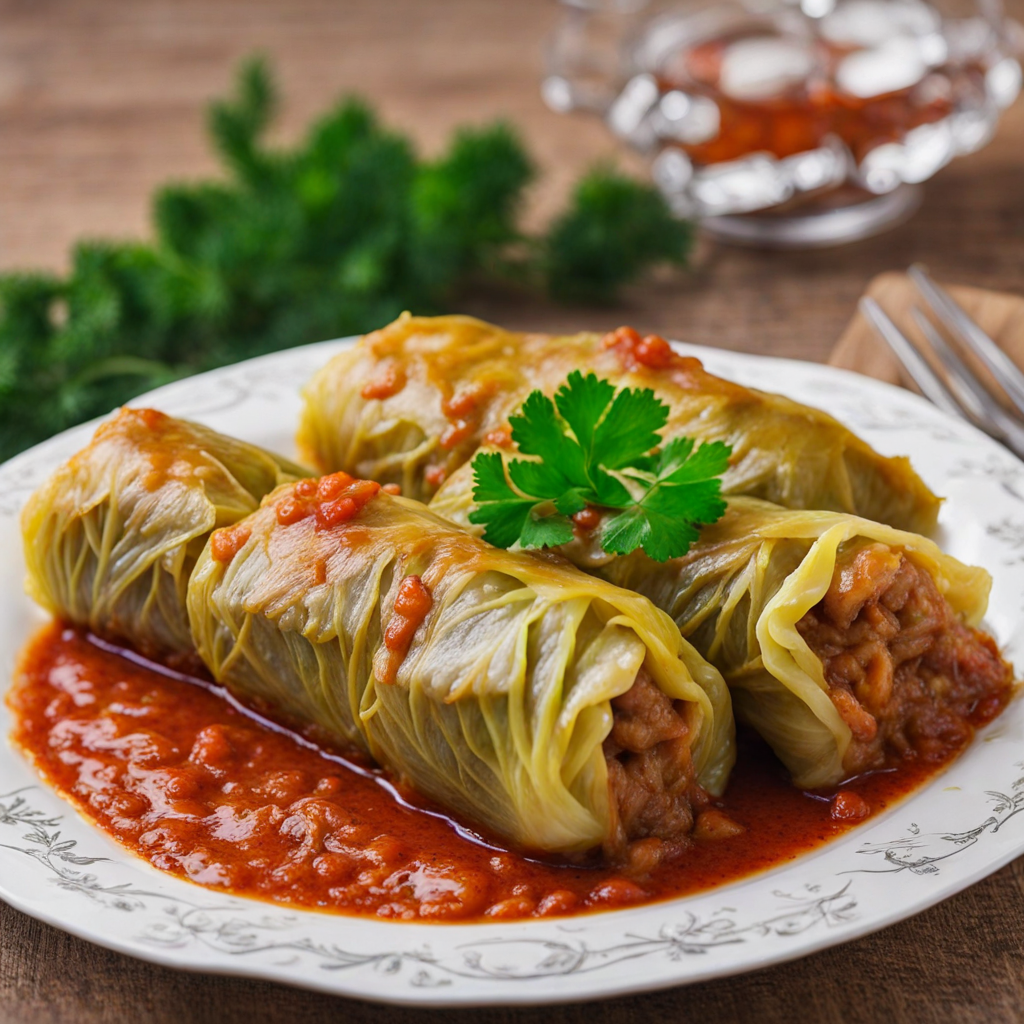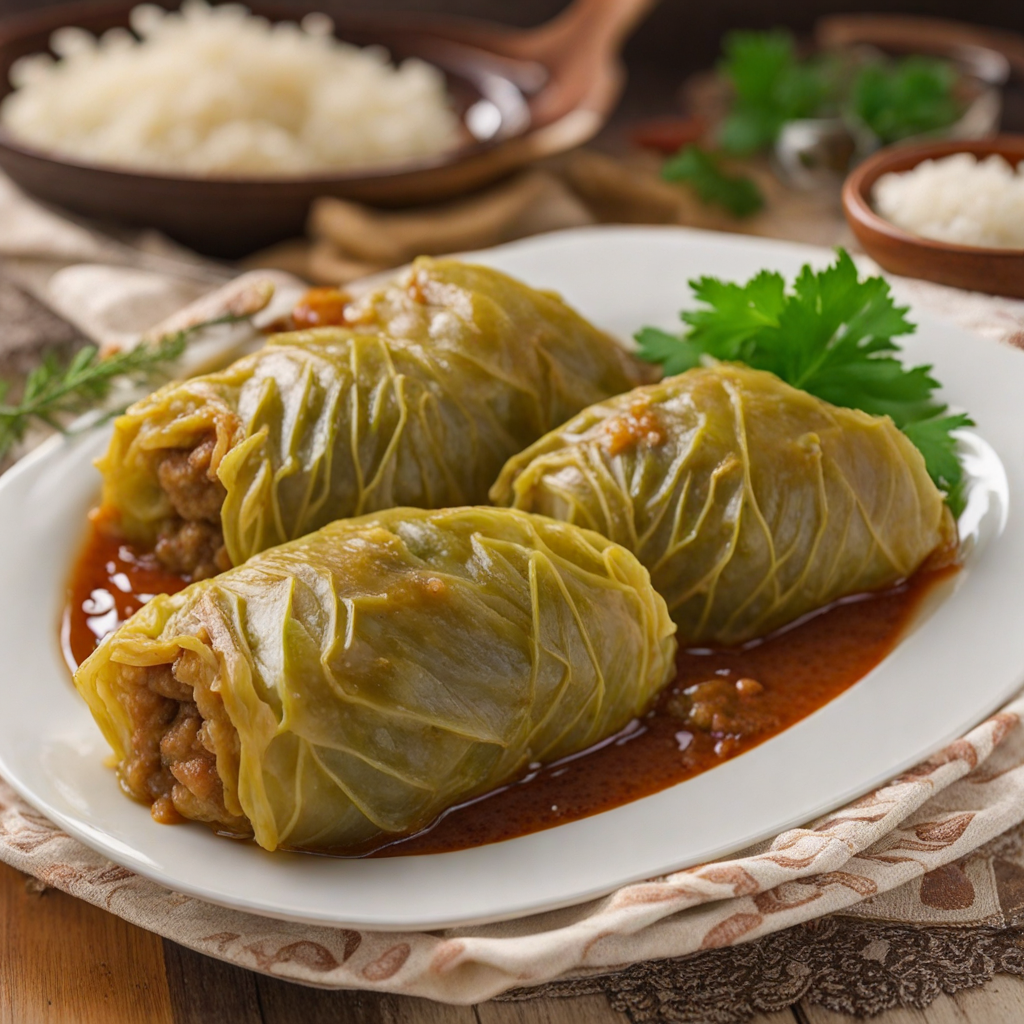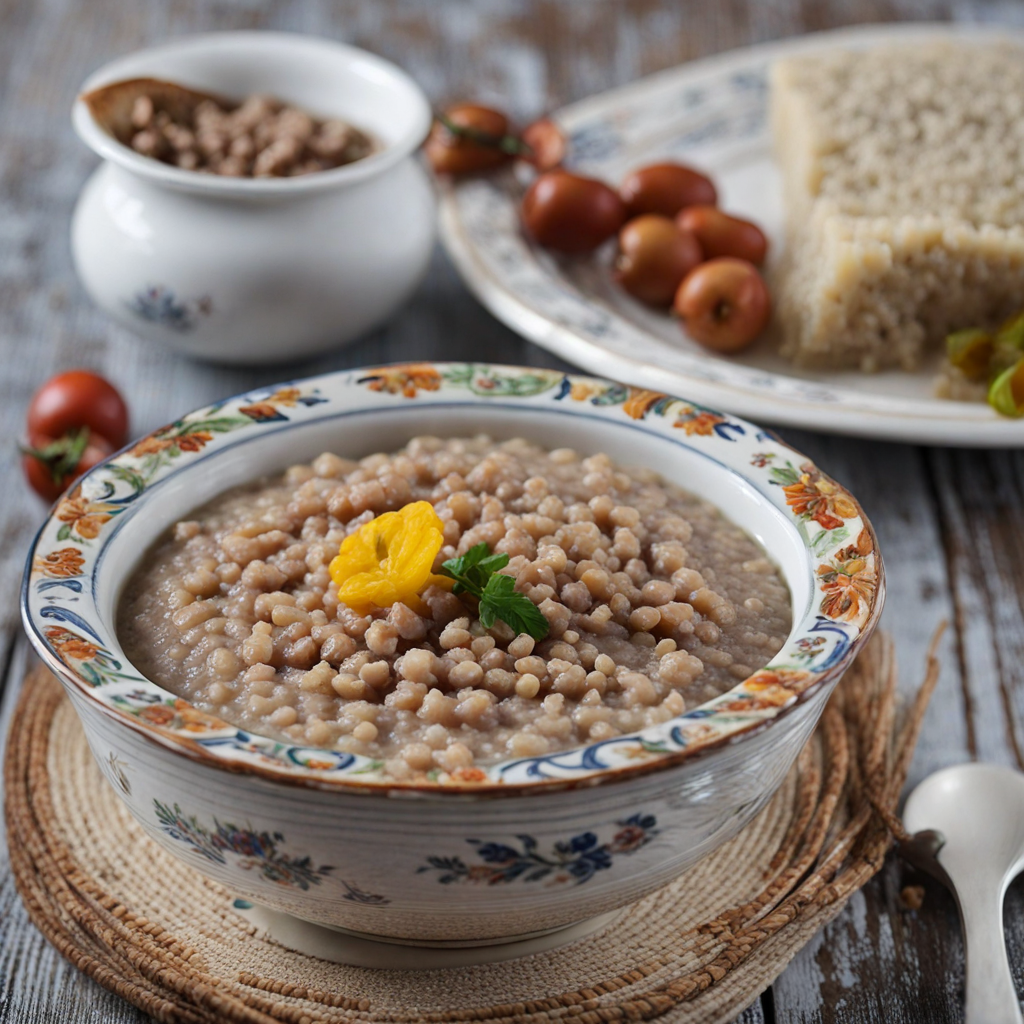Sarma
Sarma is a beloved dish hailing from Bosnia and Herzegovina, characterized by its comforting, homey flavors. This culinary delight consists of tender cabbage leaves stuffed with a savory filling, typically made from minced meat—often a mix of beef and pork—combined with rice, onions, and a blend of spices. The leaves are meticulously wrapped around the filling, creating neat, cylindrical parcels that are then simmered in a rich, aromatic broth. The slow cooking process allows the flavors to meld beautifully, resulting in a dish that's not only hearty but deeply satisfying. The taste of Sarma is a harmonious balance of savory and slightly tangy notes, thanks to the fermented cabbage leaves, which impart a unique depth of flavor. The filling is often seasoned with herbs like dill and paprika, enhancing the dish's complexity. As it cooks, the rolls absorb the flavors of the broth, making each bite incredibly flavorful. Traditionally, Sarma is served with a dollop of thick, creamy yogurt or sour cream, which adds a refreshing contrast to the richness of the dish. Sarma is more than just a meal; it’s a cultural experience, often prepared for special occasions and family gatherings. Each family may have its own secret recipe or twist on the classic, making it a personal and cherished dish. Whether enjoyed on a chilly winter day or shared among loved ones during festive celebrations, Sarma encapsulates the warmth and hospitality of Bosnian cuisine, inviting adventurous eaters to discover its delightful flavors.
How It Became This Dish
The Culinary Legacy of Sarma: A Taste of Bosnia and Herzegovina Sarma, a beloved dish in Bosnia and Herzegovina, is a culinary masterpiece that exemplifies the rich tapestry of Eastern European food culture. This dish, typically made from minced meat and rice wrapped in pickled cabbage leaves, is more than just a meal; it is a symbol of tradition, communal spirit, and cultural heritage. The history of sarma is intertwined with the social and historical developments of the region, revealing layers of influence, adaptation, and the enduring significance of food in community life. #### Origins of Sarma The origins of sarma can be traced back to the Ottoman Empire, which, at its height, spanned across large parts of Southeast Europe, including the territories that would become Bosnia and Herzegovina. The word "sarma" itself is derived from the Turkish word "sarmak," which means "to wrap," highlighting the dish's roots in the culinary practices of the Ottoman period. Similar dishes can be found in various cultures throughout the Balkans and the Middle East, suggesting a shared culinary heritage shaped by migration, trade, and conquest. The use of pickled cabbage leaves in sarma is particularly significant. Cabbage has been cultivated in Europe since antiquity, and its preservation through fermentation became a crucial method for surviving harsh winters. In Bosnia and Herzegovina, the tradition of making pickled cabbage is not just a practical food preservation technique but also a cherished seasonal activity, particularly in the late autumn when families come together to prepare for the colder months. This communal practice fosters a sense of belonging and continuity, reinforcing the cultural significance of food in Bosnian society. #### Cultural Significance Sarma holds a special place in the hearts and homes of Bosnians, often reserved for festive occasions, family gatherings, and religious celebrations. It is a dish that embodies hospitality, generosity, and the importance of sharing meals with loved ones. The preparation of sarma is often a family affair, where generations come together to roll the cabbage leaves and fill them with a mixture of minced meat, rice, and spices. This act of cooking becomes a ritual that deepens familial ties and creates lasting memories, making sarma a link between past and present. In Bosnia, sarma is not just food; it is a cultural artifact. It reflects the region's history of multiculturalism, as various ethnic groups—including Bosniaks, Serbs, and Croats—have adapted and incorporated their own flavors and ingredients into the dish. For example, while the traditional filling is often made with beef or pork, variations exist that use chicken or lamb, catering to different dietary preferences and religious practices. This adaptability is a testament to sarma's role in fostering community and inclusivity, as it can be modified to suit various tastes and beliefs. #### Development Over Time As Bosnia and Herzegovina navigated through various historical epochs, including the Ottoman rule, Austro-Hungarian occupation, and the tumultuous 20th century, sarma evolved in response to changing circumstances. During the Ottoman period, sarma was often enriched with spices and served with yogurt, reflecting the lavish dining practices of the empire. The Austro-Hungarian influence introduced new culinary techniques and ingredients, further diversifying the dish. In the aftermath of World War II and the rise of socialism in Yugoslavia, sarma became a staple in the national cuisine, enjoyed by people across ethnic lines. The state promoted traditional dishes as a way to foster unity among the diverse population, and sarma was often featured at communal feasts and celebrations. This period saw the standardization of recipes, with many families adopting similar methods for preparing sarma, yet regional variations persisted, showcasing local tastes and preferences. The disintegration of Yugoslavia in the 1990s brought about significant social and political changes, which also affected culinary practices. In the face of conflict, the act of preparing and sharing sarma took on new meaning as a form of resistance and resilience. Families continued to gather, often in makeshift kitchens, to prepare this cherished dish, reinforcing their cultural identity and sense of community amidst adversity. #### Sarma Today In contemporary Bosnia and Herzegovina, sarma remains a staple of both everyday and festive dining. It is commonly served during holidays such as Christmas and New Year's, as well as special occasions like weddings and family reunions. The dish has gained popularity beyond the borders of Bosnia, finding its way into the kitchens of Bosnian diaspora communities around the world. Here, it serves as a reminder of home, a taste of nostalgia that connects individuals to their roots. Modern interpretations of sarma continue to emerge, with chefs experimenting with various fillings, including vegetarian options that use lentils or mushrooms. These innovations reflect the growing interest in sustainability and dietary restrictions while honoring the fundamental aspects of the dish. Despite these changes, the traditional preparation methods are still revered, and many families hold onto their unique recipes, passed down through generations. The rise of social media has also contributed to the resurgence of interest in traditional dishes like sarma. Food bloggers and influencers showcase their own takes on the recipe, sharing tips, anecdotes, and cultural insights that resonate with a global audience. This digital age has allowed for a revitalization of interest in Bosnian cuisine, encouraging younger generations to engage with their culinary heritage. #### Conclusion Sarma is more than just a dish; it is a symbol of cultural identity, resilience, and community spirit in Bosnia and Herzegovina. Its historical roots, cultural significance, and ongoing evolution tell the story of a region shaped by diversity and shared traditions. As families continue to gather around the table to enjoy this beloved meal, sarma remains a testament to the enduring power of food to connect people across generations, cultures, and borders. In every bite of sarma, one can taste the history, warmth, and love that define this quintessential Bosnian dish.
You may like
Discover local flavors from Bosnia And Herzegovina







